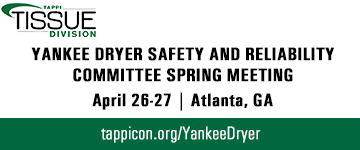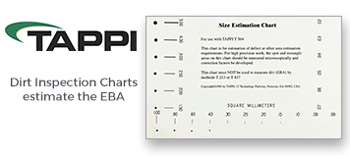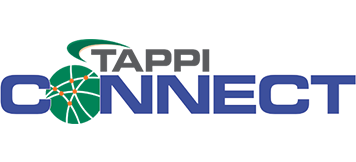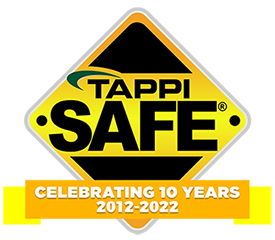 Search
Search
Use the search bar or filters below to find any TAPPI product or publication.
Filters
Content Type
Publications
Level of Knowledge
Committees
Collections
Journal articles

Magazine articles

Preparing prehydrolyzed kraft dissolving pulp via phosphotungstic acid prehydrolysis from grape branches, TAPPI Journal January 2022
ABSTRACT: Dissolving pulp was successful prepared via phosphotungstic acid (PTA) prehydrolysis kraft (PHK) cooking followed by an elementary chlorine-free (ECF) bleaching process from grape branches. The effects of prehydrolysis temperature, reaction time, and PTA concentration that potentially affect the quality of dissolving pulp product on chemical components of pulp were studied via an orthogonal experiment. The structure of lignin was activated during the PTA prehydrolysis phase, and lignin was easily removed during the following cooking process. Thus, relatively mild conditions (140°C, 100 min) can be used in the cooking process. During the prehydrolysis phase, temperature exhibited the most significant influence on the cellulose purity of the obtained pulp fiber, followed by reaction time and PTA concentration. The optimized prehydrolysis conditions were as follows: prehydrolysis temperature, 145°C; reaction time, 75 min; and PTA concentration, 1 wt%. Whether the excessively high prehydrolysis temperature or prolonging the reaction time did not favor the retention of long chain cellulose, the delignification selectivity for the cooking process could not be further improved by excessive PTA loading. Under these prehydrolysis conditions, 94.1% and 29.0% for a-cellulose content and total yield could be achieved after the given cooking and bleaching conditions, respectively. Moreover, the chemical structure and crystal form of cellulose were scarcely changed after PTA prehydrolysis, which could be confirmed by results from Fourier transform infrared (FTIR) spectroscopy and X-ray diffraction (XRD). PTA prehydrolysis could be considered as an alternative method for preparing PHK dissolving pulp under relatively mild cooking conditions.
Journal articles

Magazine articles

Application of ATR-IR measurements to predict the deinking efficiency of UV-cured inks, TAPPI Journal January 2022
ABSTRACT: In recent years, ultraviolet (UV)-curable ink has been developed and widely used in various printing applications. However, using UV-printed products (UV prints) in recovered paper recycling causes end-product dirt specks and quality issues. A new method was developed that can distinguish UV prints from other prints by means of attenuated total reflectance infrared (ATR-IR) spectroscopy. Application of this method could allow more efficient use of UV prints as raw materials for paper recycling.First, a mill trial was performed using UV prints alone as raw materials in a deinked pulp (DIP) process. Second, test prints were made with four types of UV inks: a conventional UV ink and three different highly-sensitive UV inks. Each print sample had four levels of four-color ink coverage patterns (100%, 75%, 50%, and 25%). Next, deinkability of all prints was evaluated by laboratory experiments. Finally, each print was measured using the ATR-IR method, and the relationship between the IR spectra and deinkability was investigated. Mill trial results showed that UV prints caused more than 20 times as many dirt specks as those printed with conventional oil-based ink. There were variations in recycling performance among UV prints taken from bales used for the mill trial. Lab tests clearly revealed that not all UV-printed products lead to dirt specks. In order to clarify the factors that affected deinkability of UV prints, the print samples were investigated by lab experiments. Key findings from lab experiments include: œ The number of dirt specks larger than 250 µm in diameter increased as the ink coverage increased. œ Higher ink coverage area showed stronger intensity of ATR-IR spectral bands associated with inks. These results indicate that deinkability of UV prints could be predicted by analysis of ATR-IR spectra. œ Finally, the method was applied for assessment of recovered paper from commercial printing presses. It was confirmed that this method made it possible to distinguish easily deinkable UV prints from other UV prints. Based on these findings, we concluded that the ATR-IR method is applicable for inspection of incoming recovered paper.
Journal articles

Magazine articles

Experiments and visualization of sprays from beer can and turbo liquor nozzles, TAPPI Journal February 2022
ABSTRACT: Industrial scale swirl-type black liquor nozzles were studied using water as the test fluid. Simple water spraying experiments were found to be very beneficial for studying and comparing nozzles for black liquor spraying. These kinds of experiments are important for finding better nozzle designs. Three nozzle designs were investigated to understand the functional differences between these nozzles. The pressure loss of nozzle 1 (“tangential swirl”) and nozzle 3 (“turbo”) were 97% and 38% higher compared to nozzle 2 (“tan-gential swirl”). Spray opening angles were 75°, 60°, and 35° for nozzles 1, 2, and 3, respectively. Video imaging showed that the nozzles produced sprays that were inclined a few degrees from the nozzle centerline. Spray patter-nation showed all the sprays to be asymmetric, while nozzle 2 was the most symmetric. Laser-Doppler measure-ments showed large differences in spray velocities between nozzles. The spray velocity for nozzle 1 increased from 9 m/s to 15 m/s when the flow rate was increased from 1.5 L/s to 2.5 L/s. The resulting velocity increase for nozzle 2 was from 7 m/s to 11 m/s, and for nozzle 3, it was from 8 m/s to 13 m/s. Tangential flow (swirl) directed the spray 6°–12° away from the vertical plane. Liquid sheet breakup mechanisms and lengths were estimated by analyzing high speed video images. The liquid sheet breakup mechanism for nozzle 1 was estimated to be wave formation, and the sheet length was estimated to be about 10 cm. Sheet breakup mechanisms for nozzle 2 were wave formation and sheet perforation, and the sheet length was about 20 cm. Nozzle 3 was not supposed to form a liquid sheet. Nozzle geometry was found to greatly affect spray characteristics.
Journal articles

Magazine articles

Rethinking the paper cup — beginning with extrusion process optimization for compostability and recyclability, TAPPI Journal June 2021
ABSTRACT: More than 50 billion disposable paper cups used for cold and hot beverages are sold within the United States each year. Most of the cups are coated with a thin layer of plastic — low density polyethylene (LDPE) — to prevent leaking and staining. While the paper in these cups is both recyclable and compostable, the LDPE coat-ing is neither. In recycling a paper cup, the paper is separated from the plastic lining. The paper is sent to be recycled and the plastic lining is typically sent to landfill. In an industrial composting environment, the paper and lining can be composted together if the lining is made from compostable materials. Coating paper cups with a compostable performance material uniquely allows for used cups to be processed by either recycling or composting, thus creating multiple pathways for these products to flow through a circular economy.A segment of the paper converting industry frequently uses an extrusion grade of polylactic acid (PLA) for zero-waste venues and for municipalities with ordinances for local composting and food service items. The results among these early adopters reveal process inefficiencies that elevate manufacturing costs while increasing scrap and generally lowering output when using PLA for extrusion coating. NatureWorks and Sung An Machinery (SAM) North America researched the extrusion coating process utilizing the incumbent polymer (LDPE) and PLA. The trademarked Ingeo 1102 is a new, compostable, and bio-based PLA grade that is specifically designed for the extrusion coating process. The research team identified the optimum process parameters for new, dedicated PLA extrusion coating lines. The team also identified changes to existing LDPE extrusion lines that processors can make today to improve output.The key finding is that LDPE and PLA are significantly different polymers and that processing them on the same equipment without modification of systems and/or setpoints can be the root cause of inefficiencies. These polymers each have unique processing requirements with inverse responses. Fine tuning existing systems may improve over-all output for the biopolymer without capital investment, and this study showed an increase in line speed of 130% by making these adjustments. However, the researchers found that highest productivity can be achieved by specifying new systems for PLA. A line speed increase to more than 180% and a reduction in coat weight to 8.6 µm (10.6 g/m2 or 6.5 lb/3000 ft2) was achieved in this study. These results show that Ingeo 1102 could be used as a paper coating beyond cups.
Journal articles

Magazine articles

Addressing production bottlenecks and brownstock washer optimization via a membrane concentration system, TAPPI Journal July 2021
ABSTRACT: Advancements in membrane systems indicate that they will soon be robust enough to concentrate weak black liquor. To date, the economic impact of membrane systems on brownstock washing in kraft mills has not been studied and is necessary to understand the viability of these emerging systems and their best utilization.This study investigated the savings that a membrane system can generate related to brownstock washing. We found that evaporation costs are the primary barrier for mills seeking to increase wash water usage. Without these additional evaporation costs, we showed that our hypothetical 1000 tons/day bleached and brown pulp mills can achieve annual savings of over $1.0 MM when operating at higher dilution factors and fixed pulp production rate. We then investigated the impact of increasing pulp production on mills limited by their equipment. In washer-limited mill examples, we calculated that membrane systems can reduce the annual operating cost for a 7% production increase by 91%. Similarly, in evaporator-limited mill examples, membrane systems can reduce the annual operating cost for a 7% production increase by 86%. These results indicated that membrane systems make a production increase significantly more feasible for these equipment-limited mills.
Journal articles

Magazine articles

Evaluation of soap recovery efficiency from black liquor — analytical tools, TAPPI Journal April 2023
ABSTRACT: Soap skimmings (“soap”) are typically recovered from black liquor in kraft mills that process a high percentage of softwood. In many mills, the recovery of soap is inefficient, negatively impacting performance of evaporators and recovery boilers and resulting in loss of potential revenue. A thorough evaluation of soap recovery performance in a kraft mill requires measurement of soap content in black liquor at various sampling locations, especially around the soap skimmer.The standard laboratory method for evaluating soap content in black liquor is a complex, multi-step process that relies on solvent extraction and titration; most mills send these samples to an outside laboratory for this analysis. In this study, 100 black liquor samples, with a wide range of soap concentrations, were tested by the standard solvent extraction method. After additional dilution, each sample was also tested for surface tension with a bubble pressure tensiometer. The results were found to correlate very closely with the solvent extraction tests results. This alternate method, using surface tension measurements of diluted black liquor samples, produces rapid results and can be easily implemented in most kraft mills, which would facilitate much more frequent in-house evaluations of soap recovery performance.
Journal articles

Magazine articles

Online measurement of bulk, tensile, brightness, and ovendry content of bleached chemithermomechanical pulp using visible and near infrared spectroscopy, TAPPI JOURNAL April 2018
Online measurement of bulk, tensile, brightness, and ovendry content of bleached chemithermomechanical pulp using visible and near infrared spectroscopy, TAPPI JOURNAL April 2018
Journal articles

Magazine articles

Kraft recovery boiler operation with splash plate and/or beer can nozzles — a case study, TAPPI Journal October 2021
ABSTRACT: In this work, we study a boiler experiencing upper furnace plugging and availability issues. To improve the situation and increase boiler availability, the liquor spray system was tuned/modified by testing different combinations of splash plate and beer can nozzles. While beer cans are typically used in smaller furnaces, in this work, we considered a furnace with a large floor area for the study. The tested cases included: 1) all splash plate nozzles (original operation), 2) all beer can nozzles, and 3) splash plate nozzles on front and back wall and beer cans nozzles on side walls. We found that operating according to Case 3 resulted in improved overall boiler operation as compared to the original condition of using splash plates only. Additionally, we carried out computational fluid dynamics (CFD) modeling of the three liquor spray cases to better understand the furnace behavior in detail for the tested cases. Model predictions show details of furnace combus-tion characteristics such as temperature, turbulence, gas flow pattern, carryover, and char bed behavior. Simulation using only the beer can nozzles resulted in a clear reduction of carryover. However, at the same time, the predicted lower furnace temperatures close to the char bed were in some locations very low, indicating unstable bed burning. Compared to the first two cases, the model predictions using a mixed setup of splash plate and beer can nozzles showed lower carryover, but without the excessive lowering of gas temperatures close to the char bed.
Journal articles

Magazine articles

Application of ATR-IR measurements to predict the deinking efficiency of UV-cured inks, TAPPI Journal January 2022
ABSTRACT: In recent years, ultraviolet (UV)-curable ink has been developed and widely used in various printing applications. However, using UV-printed products (UV prints) in recovered paper recycling causes end-product dirt specks and quality issues. A new method was developed that can distinguish UV prints from other prints by means of attenuated total reflectance infrared (ATR-IR) spectroscopy. Application of this method could allow more efficient use of UV prints as raw materials for paper recycling.First, a mill trial was performed using UV prints alone as raw materials in a deinked pulp (DIP) process. Second, test prints were made with four types of UV inks: a conventional UV ink and three different highly-sensitive UV inks. Each print sample had four levels of four-color ink coverage patterns (100%, 75%, 50%, and 25%). Next, deinkability of all prints was evaluated by laboratory experiments. Finally, each print was measured using the ATR-IR method, and the relationship between the IR spectra and deinkability was investigated. Mill trial results showed that UV prints caused more than 20 times as many dirt specks as those printed with conventional oil-based ink. There were variations in recycling performance among UV prints taken from bales used for the mill trial. Lab tests clearly revealed that not all UV-printed products lead to dirt specks. In order to clarify the factors that affected deinkability of UV prints, the print samples were investigated by lab experiments. Key findings from lab experiments include: • The number of dirt specks larger than 250 µm in diameter increased as the ink coverage increased. • Higher ink coverage area showed stronger intensity of ATR-IR spectral bands associated with inks. These results indicate that deinkability of UV prints could be predicted by analysis of ATR-IR spectra. • Finally, the method was applied for assessment of recovered paper from commercial printing presses. It was confirmed that this method made it possible to distinguish easily deinkable UV prints from other UV prints. Based on these findings, we concluded that the ATR-IR method is applicable for inspection of incoming recovered paper.
Journal articles

Magazine articles

Three-dimensional visualization and characterization of paper machine felts and their relationship to their properties and dewatering performance, TAPPI Journal July 2021
ABSTRACT: Polymeric felts are commonly used in the papermaking process on the paper machine wet end, in the press section, and in the dryer section. They provide an important function during paper manufacturing, including as a carrier or support; as a filter media assisting with water removal on the paper machine; in retention of fibers, fines, and fillers; and in some applications, such as tissue and towel, to impart key structural features to the web. These felts can have highly interwoven complex internal structures comprised of machine direction and cross-machine direction yarns of varying sizes and chemical compositions. Here, we present a non-intrusive three-dimensional (3D) image visualization method using advanced X-ray computed tomography (XRCT). This method was used to characterize the complex 3D felt structure and determine the water removal characteristics of some commonly used paper machine felts. The structural features analyzed include porosity; specific pore-yarn interfacial surface area; 3D pore size distribution; 3D fiber or yarn-size distribution; and their variations through the thickness direction. The top, middle, and bottom layers of the felt have very different structures to assist with water removal and impart paper properties. The size distribution of the yarns, as well as the pores in the different layers of the felt, are also inherently different. These structural features were non-intrusively quantified. In addition, variation in the structural characteristics through the thickness of the felts and its potential role in papermaking is explored. In addition to the 3D structural characteristics, permeability characteristics and water removal characteristics, including rewetting of select felt samples, have also been experimentally determined. It is interesting to observe the relationship between key structural features and permeability and water removal characteristics. These relationships can provide additional insights into press felt design, as well as ways to improve product properties and the dewatering efficiency and productivity of the paper machine.





